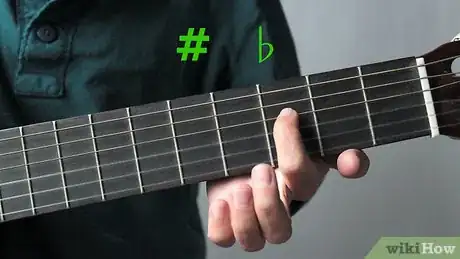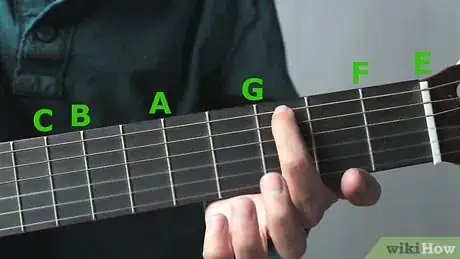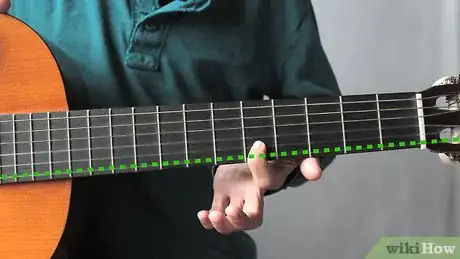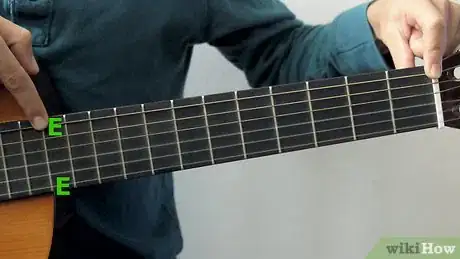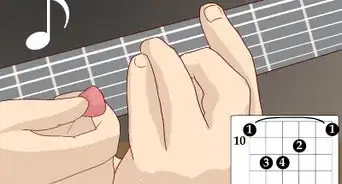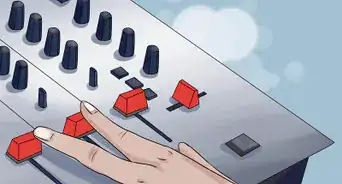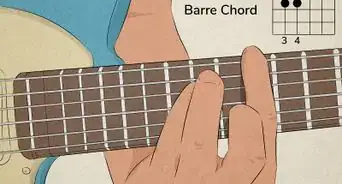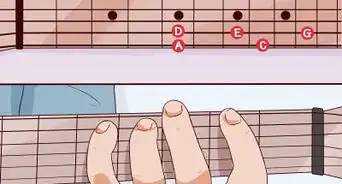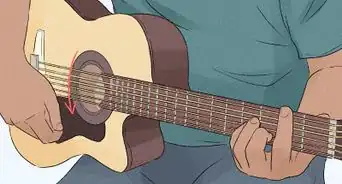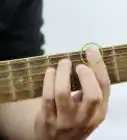This article was co-authored by Nate Savage. Nate Savage is a professional guitarist with over 16 years of experience teaching guitar to students around the world. His YouTube channel, Guitareo, has over 450,000 subscribers.
wikiHow marks an article as reader-approved once it receives enough positive feedback. This article received 20 testimonials and 84% of readers who voted found it helpful, earning it our reader-approved status.
This article has been viewed 987,092 times.
Unlike piano keys, there is no obvious repeating pattern to the notes on a guitar. In order to learn chords, riffs, and songs, you will have to first know the names of the notes of the fretboard. With a little patience and a very basic understanding of guitars and musical theory, anyone can make knowing the notes on a guitar feel like second nature.
Note: This is for "Standard Tuning," the most common string pattern on a guitar. In standard tuning, from topmost string to bottom-most, the open strings are E A D G B E.
Steps
Learning the Essentials
-
1Learn the open strings, or the notes for each string if you aren't holding down a fret. The guitar is made up of six strings, with the thickest, heaviest string on top and the thinnest on the bottom. Guitar strings count from the bottom up -- so the thin string is the 1st and the thick string is the 6th. From the bottom up, the notes are E B G D A E. There are a variety of ways to remember the strings, but one of the simplest is:
- Every
- Boy
- Gets
- Dessert
- At
- Easter[1]
-
2Know that notes count alphabetically from A to G. In western music, notes are written as the letters A - G. After G, the notes cycle back to A, but a higher-pitched version of A. As you move down the fret board (towards the body of the guitar), you cycle down the notes. An E, therefore is higher up the fret board than a F, and a G, and then the next A.
- The note before is considered lower. So a B is lower than the next C.
- A note that occurs later on is a higher note. An E is a higher note than the earlier D.
Advertisement -
3Identify the sharp and flat notes in between the letters. In between the notes are sharps (represented by a #) and flats (represented by a ♭). Sharps are the notes right after a letter, like an A→ A#, and flats are right before a note, like a D♭→ E. Sharps and flats are interchangeable, depending on the song. For example, the note between a C and D is written as either a C# or a D♭. The full set of notes is:
- A, A#, B, C, C#, D, D#, E, F, F#, G, G#
- Notice that there is no such thing as E# or B#. E and B do not ever have sharps, and the notes simply skip from E→F. As such, there is no C♭ or F♭ either. If you remember this small exception to the rule, memorizing the guitar will be easy.
-
4Move down one fret to raise the note up a half-step. The frets of a guitar are numbered, with 0 being an open string, 1 being the fret closest to the head, and so on. A half-step is simply moving from one note to the next (A→ A#), including the sharps and flats, whereas a full-step jumps two notes (A→ B, B→ C#). Each fret represents a half step up from the one before it. So:
- On the top string, the first note (an open string) is E.
- The first fret on the top string is an F (remember, there is no such thing as E#).
- The second fret on the top string is an F#.
- The third fret on the top string is a G.
- This continues all the way down. Try naming each note on one string. If you got it all right, you'll be back to E by the 12th fret.
-
5Find all of the natural notes on the first string. Natural notes are those without sharps or flats (A,B,C,D,E,F,G). The best place to begin learning is on the top (or 6th) string, the E. On this string, the first few major notes are marked by dots on the fretboard.
- E is on the open string.
- F is on the 1st fret.
- G is on the 3d fret.
- A is on the 5th fret.
- B is on the 7th fret.
- C is on the 8th fret.
- D is on the 10th fret.
- E is on the 12th fret, and the pattern repeats.
-
6Think of the guitar as having only 12 frets. Frets are the small metal bars on the neck. When you press a string down on a fret, it gives you a different note, moving down the scale. But at the 12th fret (usually noted by 2 dots on the guitar), the whole guitar resets. The 12th fret of any string is the identical note as the open string, and then everything repeats. This means you only need to learn the notes from 0-12 frets, then know that they are identical after the 12th fret.[2]
- On the twelfth fret, for example, your notes would be E B G D A E, from the bottom up.
- This is because there are only 12 notes total in Western music -- A, A#, B, C, C#, D, D#, E, F, F#, G, G#. After the 12th note you are back where you started.
Finding the Right Note Anywhere
-
1Learn each note individually, instead of trying to learn the whole guitar at once. Get the first string memorized, then focus on one letter completely. Start by finding all of the Es between the head and the 12th fret and then move on to another letter. Trying to learn all the notes at once is much too confusing to be productive, so split the task up into individual notes. There are a lot of theories out there about what order to learn notes, but a good order to try is E - G - B - F - D - A - C.
- Practice playing just that one note, using the same finger each time. Build up speed slowly until you can find every single note without looking.
- You can use the top string to locate just about every note. Once you know the notes on the low E-string you can use the following tricks to find them anywhere.
-
2Use octaves to find the same note on a lower string. Octaves are the same note, but at different pitches. Think of perfectly harmonizing singers, one who is high-pitched, one low and deep, who are singing the same note, to understand octaves. On guitars, octaves make it easy to find notes. Simply move down two strings, and then right 2 frets, and you have an octave. For example, start with your finger on the 6th string, 3rd fret. This is a G. If you move down to the 4th string, 5th fret, this is also a G.
- There is one exception to this. The 2nd string (open B) is a half-step deeper than the rest. So, to find an octave ending on the 2nd string, you go down two strings, and right three frets.
-
3Know that identical notes are only 1 string and 5 frets away. If you go down one string, then to the left 5 frets, you arrive at an identical note to the one you started on. For example, if you start on the 4th string, 10th fret, you can find an identical note on the 3rd string, 5th fret (these are both C).
- You can also go in reverse. A string higher and to the right 5 frets will also create an identical note.
- Like with octaves, the 2nd fret is the only exception. If you end on the 2nd string, you move the left 4 frets, not 5. So, the match for 3rd string, 4th fret note is an open B-string, or the 0-fret.[3]
-
4Find the patterns on the fretboard. There is a variety of tricks and patterns that can help you find notes at any time with a bit of quick thinking. Using the octaves and matching notes, you can add the following tricks to help you locate any note as you practice:
- The top and the bottom string, both E, are identical.
- The D string, the 4th string, is just the E string shifted 2 frets down.
- The G string, the 3rd string, is just the A string shifted 2 frets down.
- The B string, the 2nd string, is just the A string shifted 2 frets up.[4]
-
5Spend 5-10 minutes finding each note every time your practice. For example, for the first week, you might spend the first 5 minutes of practice finding every single E on the guitar. For the whole week, find and play every E note on the fretboard, practicing to the point where you don't need to count or find it. The next week, move on to find every single F. After a few weeks you'll have the board happily memorized.
- Pick a spot on the guitar and move only up and down on all 6 strings, hitting just the Es in your little box to where you started. Slowly build up speed as you play until you know all the Es on that section of the fretboard.
- Don't worry too much about the sharps and flats -- once you know the natural notes these will be easy to find.
-
6Learn to read music to test your knowledge. Music notation is written out in notes, so being able to quickly read music and find the matching frets on the guitar is the perfect way to learn the notes quickly and effectively. If you can get to the point of basic "sight reading," where you can look at sheet music and find the notes as you read, you've perfectly memorized the notes.
Community Q&A
-
QuestionHow can I change chords quickly?
 Community AnswerYou'll need to start slowly. Pick two chords and change between just those two. Then work on changing between those two chords a little more quickly. Once you've gotten that chord change down, work on another one. It will take time, but with practice you'll be able to fly between them.
Community AnswerYou'll need to start slowly. Pick two chords and change between just those two. Then work on changing between those two chords a little more quickly. Once you've gotten that chord change down, work on another one. It will take time, but with practice you'll be able to fly between them. -
QuestionHow long does it take to learn guitar completely?
 Community AnswerLike with all instruments, the guitar takes a lot of time and practice. There really isn't a way to "completely" learn the guitar because you are constantly learning new things and improving your skills. Learning the basics, as in chords and notes, will depend on the person learning the guitar. It can take as little as a few days to as long as a few weeks.
Community AnswerLike with all instruments, the guitar takes a lot of time and practice. There really isn't a way to "completely" learn the guitar because you are constantly learning new things and improving your skills. Learning the basics, as in chords and notes, will depend on the person learning the guitar. It can take as little as a few days to as long as a few weeks. -
QuestionWill putting stickers on a fret board really help me learn the notes faster?
 Community AnswerFor many people, this is a very effective method of memorizing the correct finger positions, so it's likely that it will be helpful for you too.
Community AnswerFor many people, this is a very effective method of memorizing the correct finger positions, so it's likely that it will be helpful for you too.
References
- ↑ http://www.guitarhabits.com/learn-the-guitar-fingerboard-thoroughly-in-16-days/
- ↑ http://www.ultimate-guitar.com/lessons/the_basics/easiest_way_to_learn_the_note_names_on_the_fretboard.html?no_takeover
- ↑ http://www.guitarlessonworld.com/lessons/learning-the-fretboard.htm
- ↑ http://www.osirisguitar.com/tricks-to-learn-all-the-notes-on-the-fretboard/
- Videos from GuitarLessons.com
About This Article
To learn all the notes on a guitar, start by learning the open strings, or the notes that each string plays if you aren’t holding down a fret. The heaviest string on top is the low E, followed by A, D, G, B, and E again. If you need help remembering those, try a mnemonic device like Every Boy Gets Dessert At Easter. Moving down a fret will raise a note up a half-step, so if you play the A string with your finger on the first fret, it will play A sharp, and so on. If you want to learn more from our Guitar Expert co-author, like how to find patterns on the fretboard, keep reading the article!


